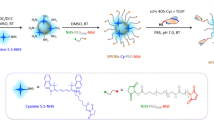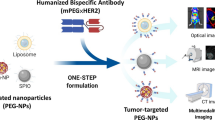Abstract
We report the development of Herceptin-conjugated fluorescent polymeric nanoparticles (PNp) probes. Synthesis of fluorescent conjugated polymer as the core, preparation of the core/shell PNp, the ability of immobilizing Herceptin on PNp, targeting and imaging of bioconjugated PNp toward HER2-overexpressing cancer cells, and therapeutic effect on cell cycle, together with the expression of apoptosis related proteins, were investigated. We have achieved active tumor targeting by rapid PNp-antibody binding to tumor-specific antigens. Besides, Herceptin-conjugated PNp can suppress the growth of HER2-overexpressing cancer cells.





Similar content being viewed by others
References
Nicolette CA, Miller GA (2003) The identification of clinically relevant markers and therapeutic targets. Drug Discov Today 8(1):31–38
Sun C, Sze R, Zhang M (2006) Folic acid-PEG conjugated superparamagnetic nanoparticles for targeted cellular uptake and detection by MRI. J Biomed Mater Res A 78A(3):550–557
Toublan FJJ, Boppart S, Suslick KS (2006) Tumor targeting by surface-modified protein microspheres. J Am Chem Soc 128(11):3472–3473
Yu X, Chen L, Deng Y, Li K, Wang Q, Li Y, Xiao S, Zhou L, Luo X, Liu J, Pang D (2007) Fluorescence analysis with quantum dot probes for hepatoma under one- and two-photon excitation. J Fluoresc 17(2):243–247
Xue FL, Chen JY, Guo J, Wang CC, Yang WL, Wang PN, Lu DR (2007) Enhancement of intracellular delivery of CdTe quantum dots (QDs) to living cells by tat conjugation. J Fluoresc 17(2):149–154
Yang CS, Chang CH, Tsai PJ, Chen WY, Tseng FG, Lo LW (2004) Nanoparticle- based in vivo investigation on blood − brain barrier permeability following ischemia and reperfusion. Anal Chem 76(15):4465–4471
Zhao Y, Liu S, Li Y, Jiang W, Chang Y, Pan S, Fang X, Wang YA, Wang J (2010) Synthesis and grafting of folate–PEG–PAMAM conjugates onto quantum dots for selective targeting of folate-receptor-positive tumor cells. J Colloid Interf Sci 350(1):44–50
Das GK, Chan PPY, Teo A, Loo JSC, Anderson JM, Tan TTY (2010) In vitro cytotoxicity evaluation of biomedical nanoparticles and their extracts. J Biomed Mater Res A 93A(1):337–346
Chang E, Thekkek N, Yu WW, Colvin VL, Drezek R (2006) Evaluation of quantum dot cytotoxicity based on intracellular uptake. Small 2(12):1412–1417
Hsieh SR, Chang CJ, Way TD, Kwan PC, Hung TW (2009) Preparation and non-invasive in-vivo imaging of anti-adhesion barriers with fluorescent polymeric marks. J Fluoresc 19(4):733–740
Way TD, Hsieh SR, Chang CJ, Hung TW, Chiu CW (2010) Preparation and characterization of branched polymers as postoperative anti-adhesion barriers. Appl Surf Sci 256(10):3330–3336
Pei Q, Yang Y (1996) Efficient photoluminescence and electroluminescence from a soluble polyfluorene. J Am Chem Soc 118(31):7416–7417
Feng X, Tang Y, Duan X, Liu L, Wang S (2010) Lipid-modified conjugated polymer nanoparticles for cell imaging and transfection. J Mater Chem 20:1312–1316
Stearns V, Schneider B, Henry NL, Hayes DF, Flockhart DA (2006) Breast cancer treatment and ovarian failure: risk factors and emerging genetic determinants. Nat Rev Cancer 6:886–893
Slamon D, Godolphin W, Jones L, Holt J, Wong S, Keith D, Levin W, Stuart S, Udove J, Ullrich A (1989) Studies of the HER-2/neu proto-oncogene in human breast and ovarian cancer. Science 244(4905):707–712
Slamon D, Clark G, Wong SG, Levin W, Ullrich A, McGuire W (1987) Human breast cancer: correlation of relapse and survival with amplification of the HER-2/neu oncogene. Science 235(4785):177–182
Yu D, Hung MC (2000) Role of erbB2 in breast cancer chemosensitivity. Oncogene 22(7):673–680
Lee JC, Tsai CY, Kao JY, Kao MC, Tsai SC, Chang CS, Huang LJ, Kuo SC, Lin JK, Way TD (2008) Geraniin-mediated apoptosis by cleavage of focal adhesion kinase through up-regulation of Fas ligand expression in human melanoma cells. Mol Nutr Food Res 52(6):655–663
Schwartz BJ (2003) Conjugated polymers as molecular materials: how chain conformation and film morphology influence energy transfer and interchain interactions. Annu Rev Phys Chem 54:141–172
Chandler D (2005) Interfaces and the driving force of hydrophobic assembly. Nature 437:640–647
Wong KF, Skaf MS, Yang CY, Rossky PJ, Bagchi B, Hu D, Yu J, Barbara PF (2001) Structural and electronic characterization of chemical and conformational defects in conjugated polymers. J Phys Chem B 105(26):6103–6107
Martini IB, Smith AD, Schwartz BJ (2004) Exciton-exciton annihilation and the production of interchain species in conjugated polymer films: Comparing the ultrafast stimulated emission and photoluminescence dynamics of MEH-PPV. Phys Rev B: Condens Matter B69:035204
Hun X, Zhang Z, Tiao L (2008) Anti-Her-2 monoclonal antibody conjugated polymer fluorescent nanoparticles probe for ovarian cancer imaging. Anal Chim Acta 625(2):201–206
Park JW, Hong K, Zalipsky S, Li WL, Carter P, Benz CC, Papahadjopoulos D (1997) Sterically stabilized anti-HER2 immunoliposomes: design and targeting to human breast cancer cells in vitro. Biochemistry 36(1):66–75
Fulda S, Debatin KM (2006) Extrinsic versus intrinsic apoptosis pathways in anticancer chemotherapy. Oncogene 25:4798–4811
Peralta-Leal A, Rodríguez MI, Oliver FJ (2008) Poly(ADP-ribose)polymerase-1 (PARP-1) in carcinogenesis: potential role of PARP inhibitors in cancer treatment. Clin Transl Oncol 10(6):318–323
Acknowledgements
The authors would like to thank the financial support from the National Science Council, Feng Chia University and China Medical University.
Author information
Authors and Affiliations
Corresponding author
Additional information
Chi-Jung Chang and Tzong-Der Way contributed equally to this work.
Rights and permissions
About this article
Cite this article
Way, TD., Chang, CJ. & Lin, CW. Bioconjugated Fluorescent Polymeric Nanoparticles for Imaging and Targeted Therapy of HER2-Overexpressing Cancer Cells. J Fluoresc 21, 1669–1676 (2011). https://doi.org/10.1007/s10895-011-0856-9
Received:
Accepted:
Published:
Issue Date:
DOI: https://doi.org/10.1007/s10895-011-0856-9




